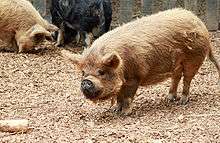Kunekune
 Kunekunes at the Hamilton Zoo | |
| Conservation status | Rare |
|---|---|
| Country of origin | New Zealand |
| Traits | |
|
Pig Sus scrofa domesticus | |
The kunekune /ˈkuːnɪkuːnɪ/[1] is a small breed of domestic pig from New Zealand. Kunekune are hairy, with a rotund build and may bear wattles (or piri piri) hanging from their lower jaws. Their colour ranges from black and white, to ginger, cream, gold-tip, black, brown and tricoloured. They have a docile, friendly nature, and – like the pot-bellied pig – are now often kept as pets.
Origin
The kunekune is believed to have descended from an Asian domestic breed introduced to New Zealand in the early 19th century by whalers or traders. They differ markedly from the feral pig of European origin known in New Zealand as a "Captain Cooker".[2] The native Māori people of New Zealand adopted kunekune: the word kunekune means "fat and round" in the Māori language.[3]
Rarity
By the 1980s, only an estimated 50 purebred kunekune remained. Michael Willis and John Simister, wildlife-park owners, started a breeding recovery program, which in turn encouraged other recovery efforts. As of 2010, the breed no longer faces extinction, with breed societies in both New Zealand and the United Kingdom. In 1993 two were imported into the United States from the UK.
Appearance
The kunekune is covered in hair which can be long or short, and straight or curly. Hair colours include black, brown, ginger, gold, cream, and spotted combinations. It has a medium to short snout, that is black and either semilopped or pricked ears. It has a short, round body with short legs and two tassels (called piri piri) under its chin. The kunekune stands about 60 cm (24 in) tall, making it one of the smallest domesticated breeds of pig. An adult kunekune can weigh between 60 and 200 kg, well below the 400 kg of commercial pigs.[4]
Personality
Kunekune are suitable for a novice owner, as they are placid, friendly, and love human company. They are easy to train and intelligent.
Habitat
The natural habitat for kunekune is woodland and pasture. They love being outdoors and are suitable for a range of climates, in addition to being ideal for large gardens. For keeping them as pets, it is best to buy an arc (a house for the pigs) at least 2 m in size, depending on the number of pigs.
Diet
Kunekune are very easy to manage as they have the ability to fatten on little more than grass. They are the only true grazing pig and can be maintained with grass alone without supplementary feeding. An acre of grass can sustain as many as 5 kunekunes.
Breeding
Kunekune boars are fertile at 6 to 7 months and the gilts, (young females), can become pregnant at 5 months. However, gilts are not normally put to the boar until they are a year old. The sows are good mothers and the litters vary in size averaging around seven piglets. In Holland are also a number of top breeders, like De Zwijnenborgh in Lattrop,
References
- ↑
- ↑ "Captain Cooker", Te Ara
- ↑ About Kunekunes
- ↑ The New Zealand Kunekune Association. ""Miniature" kunekune pigs". The New Zealand Kunekune Association. Retrieved 2015-08-07.
External links
| Wikimedia Commons has media related to Kunekune. |
- The New Zealand Kunekune Breeders' Association
- The Dutch Kunekune Breeders Association
- The British Kunekune Pig Society
- The American KuneKune Pig Society
- DNA studies
- Dutch Breeder of Kunekune Pigs
- De Zwijnenborgh in Lattrop